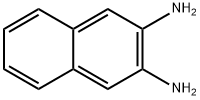1,4-Naphthalenedicarboxylic acid
- CAS NO.:605-70-9
- Empirical Formula: C12H8O4
- Molecular Weight: 216.19
- MDL number: MFCD00014312
- EINECS: 210-094-7
- SAFETY DATA SHEET (SDS)
- Update Date: 2024-12-18 14:15:30

What is 1,4-Naphthalenedicarboxylic acid?
Chemical properties
White solid
The Uses of 1,4-Naphthalenedicarboxylic acid
It is an important raw material and intermediate used in organic synthesis, pharmaceuticals, agrochemicals and dyestuff.
What are the applications of Application
1,4-Naphthalenedicarboxylic acid is widely used in dyes, optical brighteners, high-adhesion coatings, and plastics. It can be used as an important intermediate in organic synthesis to manufacture high-performance polyester fibers and insulation materials. It is an important monomer for polyethylene naphthalate (PEN), liquid crystal polymers, and polyurethane resins. It is used in the pharmaceutical field and has certain applications.
Properties of 1,4-Naphthalenedicarboxylic acid
| Melting point: | >300 °C (lit.) |
| Boiling point: | 490.2±28.0 °C(Predicted) |
| Density | 1.54 g/cm3 |
| storage temp. | Sealed in dry,Room Temperature |
| form | powder to crystal |
| pka | 2.71±0.10(Predicted) |
| color | White to Yellow to Orange |
| Water Solubility | Insoluble in water. |
| BRN | 2051255 |
| InChI | InChI=1S/C12H8O4/c13-11(14)9-5-6-10(12(15)16)8-4-2-1-3-7(8)9/h1-6H,(H,13,14)(H,15,16) |
| CAS DataBase Reference | 605-70-9(CAS DataBase Reference) |
| EPA Substance Registry System | 1,4-Naphthalenedicarboxylic acid (605-70-9) |
Safety information for 1,4-Naphthalenedicarboxylic acid
| Signal word | Warning |
| Pictogram(s) |
 Exclamation Mark Irritant GHS07 |
| GHS Hazard Statements |
H315:Skin corrosion/irritation H319:Serious eye damage/eye irritation H335:Specific target organ toxicity, single exposure;Respiratory tract irritation |
| Precautionary Statement Codes |
P302+P352:IF ON SKIN: wash with plenty of soap and water. P305+P351+P338:IF IN EYES: Rinse cautiously with water for several minutes. Remove contact lenses, if present and easy to do. Continuerinsing. |
Computed Descriptors for 1,4-Naphthalenedicarboxylic acid
| InChIKey | ABMFBCRYHDZLRD-UHFFFAOYSA-N |
| SMILES | C1(C(O)=O)=C2C(C=CC=C2)=C(C(O)=O)C=C1 |
New Products
Tert-butyl bis(2-chloroethyl)carbamate 4-Methylphenylacetic acid N-Boc-D-alaninol N-BOC-D/L-ALANINOL N-octanoyl benzotriazole 3-Morpholino-1-(4-nitrophenyl)-5,6-dihydropyridin- 2(1H)-one Furan-2,5-Dicarboxylic Acid DIETHYL AMINOMALONATE HYDROCHLORIDE 1,1’-CARBONYLDIIMIDAZOLE R-2-BENZYLOXY PROPIONIC ACID 1,1’-CARBONYLDI (1,2-4 TRIAZOLE) N-METHYL INDAZOLE-3-CARBOXYLIC ACID (2-Hydroxyphenyl)acetonitrile 4-Bromopyrazole 5-BROMO-2CYANO PYRIDINE 5,6-Dimethoxyindanone 5-broMo-2-chloro-N-cyclopentylpyriMidin-4-aMine 2-(Cyanocyclohexyl)acetic acid 4-methoxy-3,5-dinitropyridine 1-(4-(aminomethyl)benzyl)urea hydrochloride 2-aminopropyl benzoate hydrochloride diethyl 2-(2-((tertbutoxycarbonyl)amino) ethyl)malonate tert-butyl 4- (ureidomethyl)benzylcarbamate Ethyl-2-chloro((4-methoxyphenyl)hydrazono)acetateRelated products of tetrahydrofuran








You may like
-
 Naphthalene-1,4-dicarboxylic acid CAS 605-70-9View Details
Naphthalene-1,4-dicarboxylic acid CAS 605-70-9View Details
605-70-9 -
 1,4-Naphthalenedicarboxylic Acid CAS 605-70-9View Details
1,4-Naphthalenedicarboxylic Acid CAS 605-70-9View Details
605-70-9 -
 1975-50-4 98%View Details
1975-50-4 98%View Details
1975-50-4 -
 2-HYDROXY BENZYL ALCOHOL 98%View Details
2-HYDROXY BENZYL ALCOHOL 98%View Details
90-01-7 -
 2-Chloro-1,3-Bis(Dimethylamino)Trimethinium Hexafluorophosphate 221615-75-4 98%View Details
2-Chloro-1,3-Bis(Dimethylamino)Trimethinium Hexafluorophosphate 221615-75-4 98%View Details
221615-75-4 -
 14714-50-2 (2-Hydroxyphenyl)acetonitrile 98+View Details
14714-50-2 (2-Hydroxyphenyl)acetonitrile 98+View Details
14714-50-2 -
 118753-70-1 98+View Details
118753-70-1 98+View Details
118753-70-1 -
 733039-20-8 5-broMo-2-chloro-N-cyclopentylpyriMidin-4-aMine 98+View Details
733039-20-8 5-broMo-2-chloro-N-cyclopentylpyriMidin-4-aMine 98+View Details
733039-20-8
Statement: All products displayed on this website are only used for non medical purposes such as industrial applications or scientific research, and cannot be used for clinical diagnosis or treatment of humans or animals. They are not medicinal or edible.